Features
In recent years, climate concerns have shot up the political agenda but not long ago environmentalists, who warned about the impact of human activity on the planet, were generally seen as fringe or even eccentric figures. Oxford professor, Philip Stier, is now at the forefront of climate science, as a leading researcher into clouds. He was very much ahead of the curve, but is the complete antithesis of the eccentric academic.
In the days before social media, there was little interest in what one school child had to say about climate change. And, when the young Philip announced he wanted study climate, his friends thought there was little future in it
As a schoolboy in Germany in the 1990s, he was worried about the environment, so worried he had a file where he would keep the newspaper stories which appeared from time to time. And, while his friends cruised to school by car, he doggedly rode his bike past them, as they climbed into their cars, and went to the station and where he would take a train to class. It took a bit longer and was a bit less comfortable. His friends thought he was a bit mad. But, he recalls, ‘I was agitated about climate, even then.’
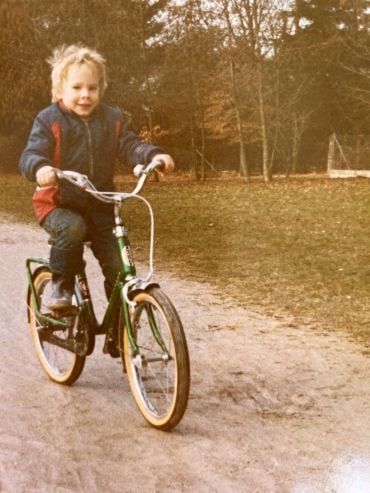 Professor Stier went to school by bike. His friends thought he was a bit mad.
Professor Stier went to school by bike. His friends thought he was a bit mad. In the days before social media, though, there was little interest in what one school child had to say about climate change. And, when the young Philip announced he wanted study climate at university, his friends and even some family, thought there was little future in it.
He laughs, ‘They said I would either become a ‘weather frog’ [a German TV forecaster] or a taxi driver...climate science wasn’t seen as likely to lead to a career.’
But Philip liked science, particularly Physics, and he was determined to study the link between climate and human activity. So, to the amusement of others, he chose to take meteorology at Munich, his local university. While many young Physicists were set on sorting out string theory and other ‘glamour’ questions, Philip wanted to apply science to environmental questions. After his undergraduate degree, he came to the UK to take a Masters and then returned to Germany to the famous Max Planck Institute for Meteorology in Hamburg for his doctorate. No one was laughing anymore.
‘It was a perfect match,’ he says enthusiastically. ‘I started doing a lot of research on aerosols (suspended particles) in the atmosphere.’
Clouds are a particular passion for Professor Stier. He admits to being able to talk at length on the subject of clouds, and sitting against a cloudy Oxford sky is clearly at home.
Clouds are a particular passion...Clouds are fantastic...I spend a lot of time looking at clouds. They have a huge effect on the Earth’s climate
Professor Philip Stier
‘Clouds are fantastic...I spend a lot of time looking at clouds, he says. ‘They have a huge effect on the Earth’s climate.’
But he is not looking to take on a role as a UK-based weather frog. Clouds, Professor Stier says, are scientifically very important in understanding climate change and are critical to research and solutions to the crisis. He explains, ‘There are natural aerosols in the atmosphere, for instance pollen, but there are other types of aerosols, man-made aerosols, caused by pollution. They modify the climate directly [by scattering and absorption of radiation] and affect clouds [which, in turn, affect the environment and climate]. This is because each cloud droplet in the atmosphere forms on an aerosol particle.’
These ‘polluted clouds’, which contain more aerosols and hence more cloud droplets, are brighter, says Professor Stier, ‘reflecting more sunlight back to space and therefore cooling the Earth’. However, aerosols also reduce the air quality and affecting people’s health, especially all over the developing world. Some of the aerosols, like sulfuric acid, are also chemically formed from gaseous emissions inside of cloud droplets. The more emissions we pump out, the more clouds become carriers of harmful pollution.
Like acid rain?
‘Yes,’ he says. ‘Like acid rain.’
Then, puncturing the sense of getting something right, he adds, ‘We tell our undergraduates, there are no wrong questions in Physics.’
Can you tell which are polluted clouds, just by looking at them?
‘That’s a big question,’ he says, with an air of knowing the answer. ‘The clouds, which contain more aerosols, are brighter but it is impossible to tell from looking at a single polluted cloud how much brighter it is than in its natural state. We are looking now at new ways how they can be identified, which includes tracks from known pollution sources, such as ships and volcanoes, or new artificial intelligence techniques that allow us to analyse vast amounts of satellite data.’
The professor is very much against the ‘doomsday’ scenarios of popular culture, where menacing clouds precipitate the end of civilisation
There may be no wrong questions, but there are some very difficult answers in respect of cloud research. The science is not as simple as: reduce emissions, everything is all right.
Professor Stier reveals that, actually, even though they may be purveyors of pollution, aerosols partly shield us from the impact of climate change.
‘It’s a balancing act,’ he says. Getting rid of air pollution may actually increase the global temperature in the short term.
‘Uncertainty is very large,’ he says, of what may be the effect. ‘There is no doubt the greenhouse gas effect is happening and we know aerosols cool the Earth.’
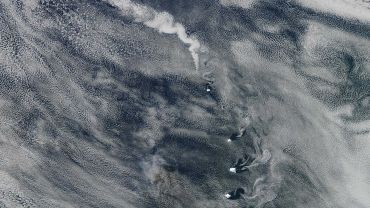 Like a Bond movie: Volcano Albedo Effect Vortex clouds
Like a Bond movie: Volcano Albedo Effect Vortex cloudsBut this is not a reason to pump out more pollutants, he insists.
‘We have to go to net zero, it is very urgent,’ he says. Man-made aerosols have devastating health impacts on parts of the developing world in particular, says Professor Stier. But take away their brightening of cloud banks reflecting back the sun’s rays and the world could become warmer in the short term (while greenhouse gas effects will dominate in the long term).
There could be increasing extreme weather events and colleagues across the University provide the scientific evidence attributing our changing weather to climate change, he says. There could be tipping points for the climate. But, although it sounds like the plot of a disaster movie, the professor is very much against the ‘doomsday’ scenarios of popular culture, where menacing clouds precipitate the end of civilisation.
In a James Bond-style plotline, he admits there has been research into using technology to mimic the cooling impact of massive volcanic eruptions or to brighten clouds to lower artificially the temperature
He maintains Oxford is a key place for cloud and climate research and he says, soothingly, this is a question of fluid dynamics, although no one fully understands what clouds will do in a changing climate. But, in a James Bond-style plotline, he admits there has been research into using technology to mimic the cooling impact of massive volcanic eruptions or to brighten clouds to lower artificially the temperature.
‘There can be a significant temperature drop for as much as two years after a volcanic eruption.’
So could we use aerosols to protect us? Er...yes, perhaps, he says.
‘It would be very risky,’ says Professor Stier. ‘If we developed technology, the global temperature could be reduced but the risk is that people would do nothing about emissions so that the radiative impact of greenhouse gases continue to accumulate. It may be possible but we don’t know what would be the impact on the e.g. ozone layer or regional climate, precipitation and extreme events. That would be a very big risk as well.’
In other words, Bond villains need not apply. Professor Stier emphasises that following the science to a net zero emission future is the best way forward. But, he admits, most scientists travel too much.
‘We have to do this for work,’ he says ruefully. But, he maintains, aeroplanes in themselves are not the real problem. It is the distance, rather than technology, which creates the large carbon footprint.
It may be possible [to use cloud technology to cool the Earth] but we don’t know what would be the impact on the ozone layer or regional climate, precipitation and extreme events. That would be a very big risk
‘Going by air is no more polluting than travelling by car – but it tends to be much longer journeys,’ he says. ‘So the impact is much larger.’
Professor Stier has a hybrid car, although he rarely drives, preferring to walk or cycle. And even used to live in the home of the freeway, Los Angeles, when he could not even drive.
‘There is a public transport system, only most people don’t use it, he laughs.
It is not easy being environmentally conscious, even now. Try to get a heat pump fitted, he says. Such small frustrations aside, Professor Stier may not believe in doomsday scenarios, but he is keen to impress that there is no time to waste. And, scientific work, into climate, including clouds, is the key to the crisis.
By Dr Marco Wittman, Department of Experimental Psychology
Have you ever played team sports? Picture how it felt when your team succeeded. You probably think the whole team performed well and everyone contributed to the win. Indeed, being part of a well-performing team can make us feel more capable ourselves. But if the team performs poorly, we can feel less competent than we actually are. In fact, this phenomenon is one that we discovered a few years ago called self-other-mergence.
One reason why self-other-mergence is such an interesting phenomenon is that we can link it to a very specific region in prefrontal cortex. The prefrontal cortex is the part of our brain that is responsible for higher cognitive functions such as learning, conceptual thinking and decision making.
In neuroscience, we know a lot about how we perceive and value objects in the world, like money, food, etc. We know much less about how the brain perceives other people and how it perceives relationships between others and ourselves. Self-other-mergence offers a unique window into this process. It might even tell us something about what our “social default” is. Do we naturally see ourselves and others as separate individuals – or is our default predisposition to have an integrated sense of self and other? This is the question we asked in our new study.
But first things first. What exactly is self-other-mergence? Self-other-mergence means people derive an impression of their own abilities not just from their own performance. Instead, they also integrate how well other people are doing into their self-evaluation. How others make us feel about our own abilities – such as better or worse – depends on the type relationship we have with them in terms of whether we are cooperating or competing with them. We align our sense of our ability to the performance of our teammates (our cooperators).
By contrast, we overestimate the difference between us and competitors: we perceive competitors such as the opposing team as particularly strong if they are winning and underestimate their ability when they are losing.
In our study, participants were asked to play a game on a computer while lying in a neuroimaging scanner that measured their brain activity. They played rapid, simple games by pressing buttons and received feedback about how well they were doing and how well others were doing. This allowed them to learn over time about the performance levels of each player. Participants then indicated how well they expected everyone to perform in the future.
As experimenters, we knew exactly how well each player performed at each point in the experiment, and by using mathematical models, we could see self-other-mergence in the data. Interestingly, the participants naturally integrated some information about the performance of the other player into their self-image. This self-other-mergence effect is quite small, but very significant and replicates over several studies.
The key innovation of our study is that we used brain stimulation to find out how the prefrontal cortex is important for self-other-mergence. We used a brain stimulation protocol that is well known to be safe and that has no longer-term side effects. But it is able to disrupt brain activity for a short period of time. By applying brain stimulation over the prefrontal cortex while participants were in the brain scanner, we could simultaneously measure the effect of brain stimulation 1) on activity in the prefrontal cortex and 2) on the strength of the self-other-mergence effects in behaviour. This was critical for us, because it allowed us to ask how the prefrontal cortex is important for self-other-mergence. There were two possible hypotheses.
Our first hypothesis was that activity in the prefrontal cortex might be responsible for causing self-other-mergence in the same way that activity in visual parts of the brain may cause us to see visual stimuli such as faces or houses. Our alternative hypothesis was that activity in the prefrontal cortex might be important for suppressing an even higher degree of self-other-mergence, similar to the way that activity in other brain regions might be important for maintaining self-control and ensuring we do not reach out for tasty snacks when we are on a diet. Which of the two was it? Did activity in the prefrontal cortex cause or suppress self-other-mergence?
After brain stimulation, the neural signatures of self-other-mergence were no longer visible in the prefrontal cortex. This is what we expected to happen. But what we also found is that when neural activity in the prefrontal cortex is disrupted, self-other-mergence behaviour happened even more – people were even more likely than before to merge estimates of their own and the other players’ performances together.
Another way of describing this is that silencing self-other-mergence in the brain significantly increases the self-other-mergence behaviour.
This indicates that our second hypothesis was the correct one: the prefrontal cortex is indeed important for suppressing self-other-mergence rather than causing it. This means we have a natural tendency to merge self and other representations in the brain. Activity in the prefrontal cortex is critical for suppressing this mix-up and allowing us to have separate images of oneself and other people.
Our results suggest that we as humans are very social creatures indeed. We naturally have a contextually embedded and integrated sense of ourselves and others. Our estimates of the abilities of ourselves and others that are inherently interdependent. Activity in the prefrontal cortex serves to keep them separate to ensure a correctly calibrated sense of self.
Humans perceive the world around them with five senses – vision, hearing, taste, smell and touch. Many other animals are also able to sense the Earth’s magnetic field. For some time, a collaboration of biologists, chemists and physicists from the Universities of Oxford (UK) and Oldenburg (Germany) have been accumulating evidence that the magnetic sense in night migratory birds, such as the European robin, is based on a specific light‐sensitive protein in the eye. In the current edition of the journal Nature, this group demonstrates that the protein cryptochrome 4, found in birds’ retinas, is sensitive to magnetic fields and could well be the long‐sought magnetic sensor.
A collaboration of biologists, chemists and physicists have been accumulating evidence that the magnetic sense in night migratory birds, such as the European robin, is based on a specific light‐sensitive protein in the eye.
Henrik Mouritsen’s research group in Oldenburg succeeded in extracting the genetic code for cryptochrome 4 in night‐migratory European robins and then produced the protein in large quantities using bacterial cell cultures. Christiane Timmel’s and Stuart Mackenzie’s groups in the Oxford Chemistry Department then applied a wide range of magnetic resonance and novel optical techniques to study this protein and demonstrated its pronounced sensitivity to magnetic fields. The measurements required the development of new instruments by several generations of talented postdoctoral researchers and graduate students.
The team also shed light on the mechanism by which this sensitivity arises – based on electron transfer reactions triggered by absorption of blue light. Proteins like cryptochrome consist of chains of amino acids: robin cryptochrome 4 has 527 of them. Oxford’s Peter Hore and Oldenburg physicist Ilia Solov'yov performed quantum mechanical calculations supporting the idea that four of the 527 – known as tryptophans – are essential for the magnetic properties of the molecule.
According to their calculations electrons hop from one tryptophan to the next generating so‐called radical pairs which are magnetically sensitive.
According to their calculations electrons hop from one tryptophan to the next generating so‐called radical pairs which are magnetically sensitive. To test this experimentally, the team from Oldenburg produced slightly modified versions of the robin cryptochrome, in which each of the tryptophans in turn was replaced by a different amino acid to block the movement of electrons. Using the modified proteins, the Oxford groups were able to elucidate the role of different radical pairs in the observed magnetic field effects.
"We think these results are very important because they show, for the first time, that a molecule from the visual apparatus of a migratory bird is sensitive to magnetic fields" says Mouritsen. But this is not, the team emphasises, definitive proof that cryptochrome 4 is the magnetic sensor. In all experiments, the researchers examined isolated proteins in the laboratory and applied magnetic fields stronger than the Earth's magnetic field. "It therefore still needs to be shown that this is happening in birds’ eyes", Mouritsen stresses. Such studies are not yet technically possible.
However, the authors think the proteins involved could be significantly more sensitive in their native environment. In cells in the retina, the proteins are probably fixed and aligned, increasing their sensitivity to the direction of the magnetic field. Moreover, they are also likely to be associated with other proteins that could amplify the sensory signals. The search is on for these, as yet unknown, interaction partners.
These results show, for the first time, that a molecule from the visual apparatus of a migratory bird is sensitive to magnetic field.
Hore says: “If we can prove that cryptochrome 4 is the magnetic sensor we will have demonstrated a fundamentally quantum mechanism that makes animals sensitive to environmental stimuli a million times weaker than previously thought possible”.
The magnetic field effect work has been supported by external funding agencies such as DARPA; the US Air Force Office of Scientific Research; the EMF Biological Research Trust; the Office of Naval Research Global; the U.S. Army Research Office, an element of the DEVCOM Army Research Laboratory; the German Science Foundation; the SCG Innovation fund and the European Research Council. It is currently supported by the ERC Synergy Grant ‘QuantumBirds’.
Christiane Timmel is Professor of Chemistry in Oxford and Director of the Oxford Centre for Advanced Electron Paramagnetic Resonance (CAESR).
Peter Hore and Stuart Mackenzie are Professors of Chemistry in Oxford.
Full paper: Magnetic sensitivity of cryptochrome 4 from a migratory songbird, Nature (2021). DOI: 10.1038/s41586-021-03618-9, www.nature.com/articles/s41586-021-03618-9
The global climate change movement has been mapped for the first time in a ground-breaking Said Business School report, which calls for greater coordination of eco-action.
The report, Decisive Decade: Organising Climate Action, led by Marya Besharov, Professor of Organisations and Impact, and Rajiv Joshi, Executive in Residence, sets out the entire international green ecosystem and insists organisations, businesses and governments need to work together to beat climate change.
In the history of the climate change movement, the period immediately before the Paris Agreement in 2015 stands as a pivotal moment. It was an exciting time. Overall involvement in climate action intensified. Engagement from businesses, civil society organisations, governments and individual citizens increased dramatically. People were excited about the opportunities for change, and the organisations in which they participated acted on their enthusiasm.
If enthusiasm is not to be squandered and ambitious Net Zero targets achieved, urgent action is needed to bring together agents of change from business, civil society and government
The Decisive Decade: Organising Climate Action - Saïd Business School
The success of the Paris Agreement owes much to this widening engagement and commitment. But, if such enthusiasm is not to be squandered and ambitious Net Zero targets achieved, the report insists urgent action is needed to bring together agents of change from business, civil society and government.The report was commissioned by the global non-profit Mission 2020 which was established to encourage speedy implementation of the Paris Agreement.
Focusing on the distinct roles of business, philanthropic, civil society and public sector organisations, the report calls for ‘catalytic collaboration’ to achieve results.
Christiana Figueres, convenor of Mission 2020, insists greater coordination is needed across these diverse organisations in order to seize the opportunity unleashed in the wake of the Paris Agreement. Ms Figueres, also Executive Secretary of the United Nations Framework Convention on Climate Change (UNFCCC) during the Paris discussion, says business, civil society and government need to work together to stand a chance of achieving targets such as Net Zero.
Former United Nations climate change executive, Christiana Figueres insists greater coordination is needed across these diverse organisations in order to seize the opportunity unleashed in the wake of the Paris Agreement
The report uncovers key barriers to realising this potential and finds that involvement in climate action remains fragmented across sectors and suffers from limited participation of organisations in key regions of the world. Meanwhile, the various groups and organisations often frame the problem and its possible solutions differently. All of these factors, the report argues, impede coordinated, collective effort and require new strategies.
'[The extraordinary challenges we face] will not be overcome with the efforts of just one sector or community. This report … provides critical guidance for how we can be more impactful and effective together,' says Ms Figueres.
[The extraordinary challenges we face] will not be overcome with the efforts of just one sector or community. This report … provides critical guidance for how we can be more impactful and effective together
Christina Figueres
The report’s Saïd-based authors offer concrete advice on how organisations with a stake in the climate crisis can harmonise their actions, without giving up their distinct positions and approaches.
The report makes the case for ‘catalytic collaboration’ – bringing together organisations from different sectors that adopt distinct yet complementary approaches to addressing the climate crisis, grounded in nature, health, finance, sustainable development and economic justice.
Three key strategies for fostering catalytic collaboration are identified:
- Develop a shared narrative that captures the imagination of everyday citizens and powerfully conveys how social and economic systems can be transformed for the better.
- Build trust and create opportunities for joint action across sectors, regions and communities with different stakes and interests in the climate crisis.
- Strengthen accountability by creating clear pathways for corporations to meet net zero commitments and ensuring those most responsible for environmental damage are responsive to those most affected by it.
'More and more people are recognising that they, and their organisations, need to be involved in addressing climate change. This report helps them to understand how they can best contribute – what roles they can play and how to amplify their collective impact,' says Professor Besharov.
True Planet: Oxford research for a changing world
The world is in a climate crisis, and Oxford researchers are at the forefront of trying to find solutions in adaptation and resilience, nature, energy transition, clean road transport and green finance.
Our researchers are working with partners in industry, government, the third sector and at other universities to address these challenges and to propose innovative approaches and solutions. Find out more about our True Planet campaign http://bit.ly/trueplanet
When Oxford academic Dr Kira Allmann began volunteering at a library, she did not imagine it would result in a report calling for urgent government support for libraries to address deep digital inequalities.
The digital transformation of government services and private services – as with banking – has left many of the most marginalised people in our communities behind
Dr Kira Allmann
Libraries on the Front Lines of the Digital Divide summarises findings from a project in Oxfordshire libraries, written by Dr Allmann with fellow university internet experts Dr Grant Blank and Annique Wong. But it has resonance far beyond the county boundary.
Dr Allmann explains, ‘The digital transformation of government services and private services – as with banking – has left many of the most marginalised people in our communities behind. People have not been able to access their basic rights, because of lack of digital skills and access.’
The media anthropologist was one of around 80 volunteers providing free one-to-one digital assistance to library visitors, as part of a scheme to address the rising need for digital access and skills support.
Requests for digital help have varied widely, as the report reveals. Dr Allmann helped with everything from printing payslips to finding housing. She found herself showing people, with limited experience of the digital world, how to type a CV in Word or set up an email account.
‘I would painstakingly talk them through each keypress, translating slowly and carefully the visual vernacular of the digital world. (‘See that little square with a line sticking through it? That means 'compose a message'. Click on that...’)’
It was clear, libraries were providing an important service, and Dr Allmann felt she had a window into the day-to-day lived experience of digital exclusion.
Dr Allmann found herself showing people, with limited experience of the digital world, how to type a CV in Word or set up an email account
‘It seemed like an important field site,’ she said. ‘I’m always thinking like an anthropologist; I can’t turn it off. And I thought there were things happening there that weren’t appearing in the literature on digital disadvantage.’
Dr Allmann spoke with library staff members and teamed up with Dr Blank, who leads the Oxford Internet Survey, to develop a Knowledge Exchange Seed Fund project to study the digital provision of the libraries. The goal was to help the libraries learn more about customers with digital needs and understand what digital need looks like.
The project collected more than 1,000 surveys of library computer users and 19 interviews with staff and volunteers. It reviewed digital help booking records and session logs, and Dr Allmann and master’s student Annique Wong also observed and participated in digital help sessions.
Although there is an expectation everyone has access to the digital world, and everything from claiming benefits to booking vaccine appointments are done online, the team found many people are being excluded. Their key findings include:
- Nearly a third of library computer users (31.3%) don’t have a smartphone.
- Three in ten library computer users (30%) had no computer at home.
- Nearly a fifth of users (19%) had no internet connection at home.
- Over half of library computer users (58%) have incomes of £20,000 or less.
Based on the findings, the summary report makes several policy recommendations:
- Library staff’s digital skills should be enhanced, so staff are prepared for the high volume and complexity of digital help requests.
- Funding should be increased and more volunteers recruited.
- There should be a shift of focus for digital inclusion from skills to wellbeing, recognising that digital is just one aspect of a person’s social context
- Community awareness should be increased, and outreach is needed, to make libraries more welcoming for people excluded from services.
COVID-19 has altered libraries as public spaces, and most of the research took place before the first lockdown. But the team maintains libraries are a vital intervention space when it comes to digital inclusion.
Dr Blank says, ‘Looking ahead we believe libraries can become the digital inclusion hubs of the future across the UK, bringing together social support and technological access under one roof.’
Looking ahead we believe libraries can become the digital inclusion hubs of the future across the UK, bringing together social support and technological access under one roof
Dr Grant Blank
Their report argues that libraries can help to identify digital need and connect people with device donation schemes or skills learning. Libraries can be spaces for digital literacy development. But joined up thinking is needed, alongside integration with other local services - as well as more staff and volunteer time.
While the pandemic has suspended some of the library service’s digital services, including digital helper volunteer support, the library service has still been playing a key role during by offering vital access to online services. This included access to free Wi-Fi and computer terminals.
The report focuses on digital access in Oxfordshire libraries, but there are lessons for libraries across the country.
‘Going online is not optional anymore,’ says Dr Allmann. ‘We hope this report will boost the profile of libraries in the digital inclusion conversation and convince local and national governments to invest further.’
Read the full report here.
- ‹ previous
- 18 of 248
- next ›
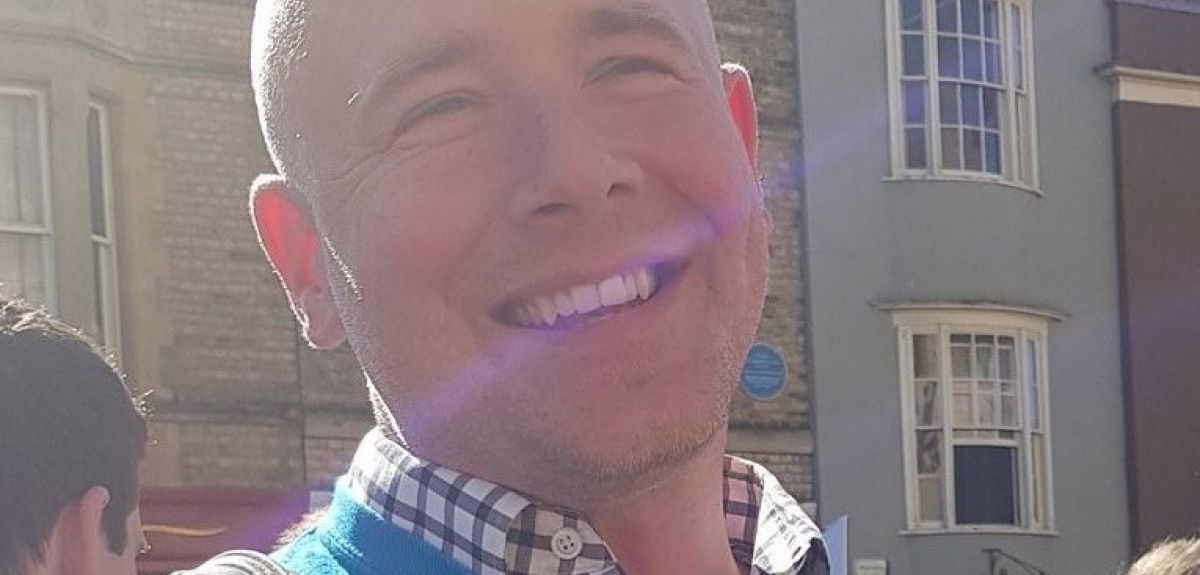
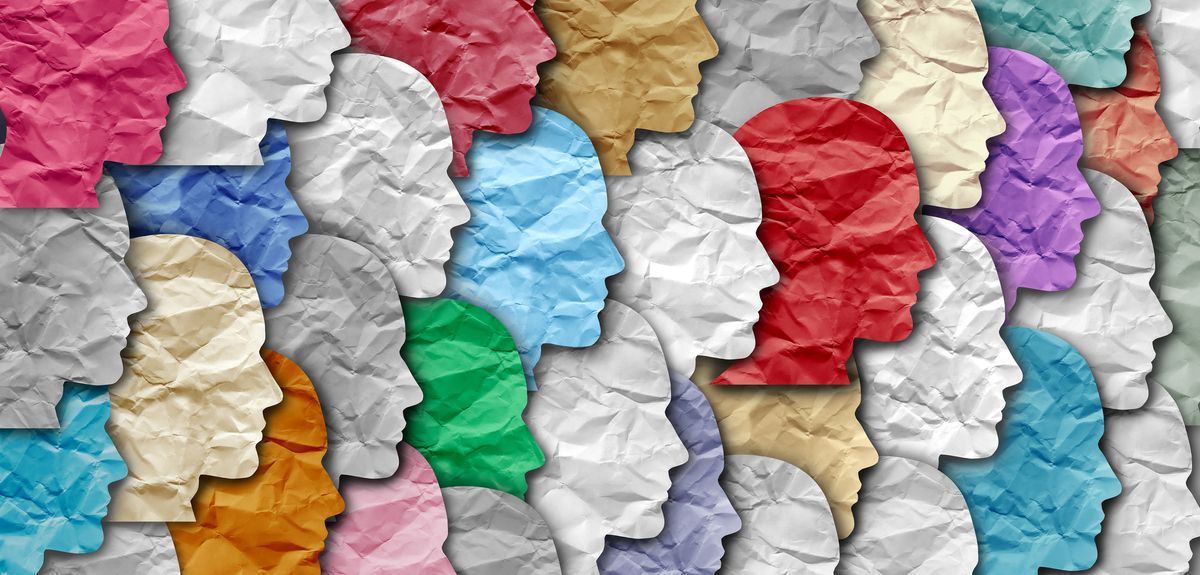
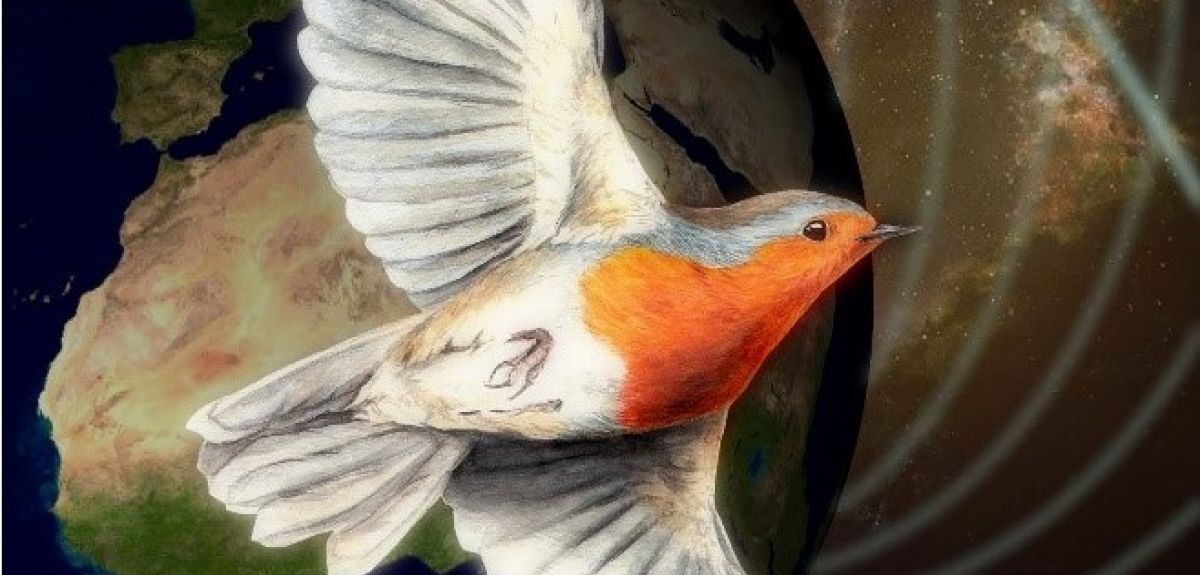
![[The extraordinary challenges we face] will not be overcome with the efforts of just one sector or community. This report … provides critical guidance for how we can be more impactful and effective together](https://www.ox.ac.uk/sites/files/oxford/styles/ow_medium_feature/s3/field/field_image_main/shutterstock_1388894738%20%281%29.jpg?itok=EDAP5Z21)
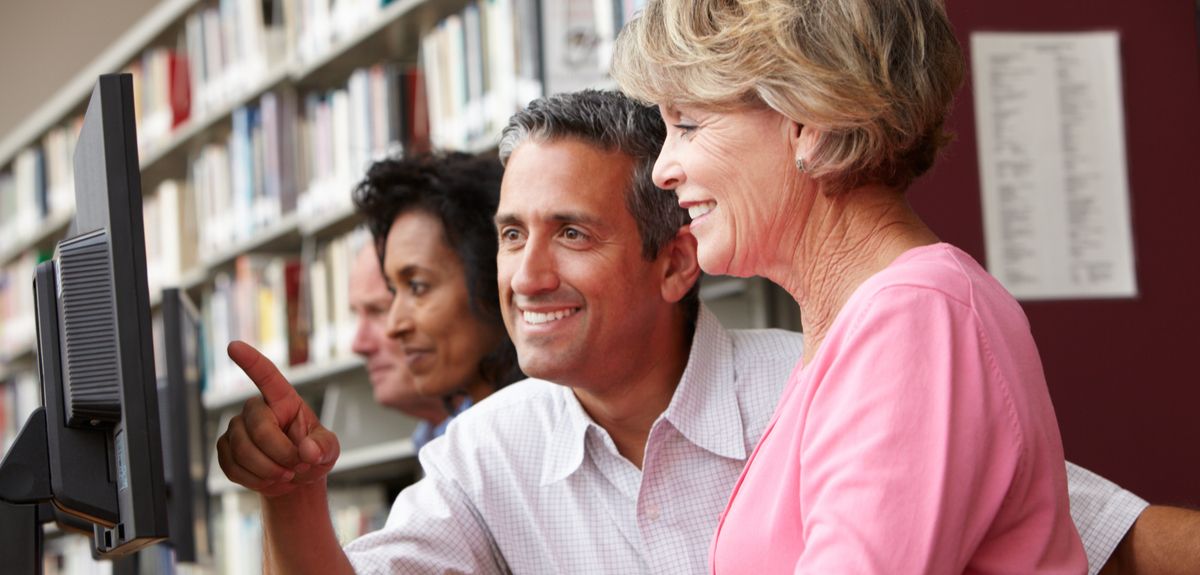
 The hidden cost of AI: In conversation with Professor Mark Graham
The hidden cost of AI: In conversation with Professor Mark Graham  Astrophoria Foundation Year: Dr Jo Begbie reflects on the programme’s first year
Astrophoria Foundation Year: Dr Jo Begbie reflects on the programme’s first year World Malaria Day 2024: an interview with Professor Philippe Guerin
World Malaria Day 2024: an interview with Professor Philippe Guerin From health policies to clinical practice, research on mental and brain health influences many areas of public life
From health policies to clinical practice, research on mental and brain health influences many areas of public life From research to action: How the Young Lives project is helping to protect girls from child marriage
From research to action: How the Young Lives project is helping to protect girls from child marriage  Can we truly align AI with human values? - Q&A with Brian Christian
Can we truly align AI with human values? - Q&A with Brian Christian  Entering the quantum era
Entering the quantum era Can AI be a force for inclusion?
Can AI be a force for inclusion? AI, automation in the home and its impact on women
AI, automation in the home and its impact on women